
iFi-Audio xDSD Specs
- Output Power: 500mW into 16Ω
- Dynamic range: 113dB
- THD+N: 0.005%
- Inputs: USB, SPDIF (coaxial / optical), Bluetooth (AptX, AAC)
- Output impedance: <1Ω
- Sample-rates: up to PCM 786 khz / DSD512 / MQA (Renderer)
Packaging
The packaging for the xDSD is typical of what you could expect from iFi in being near identical to that of the rest of their Nano line of devices.
The outer sleeve boldly displays an image of the device, along with some logos and other text to showcase the fact that the xDSD has Bluetooth functionality, is MQA compatible, and can handle up to DSD512 files.
Removing the outer sleeve leaves us with a very familiar what box that simply has the iFi logo printed in silver.
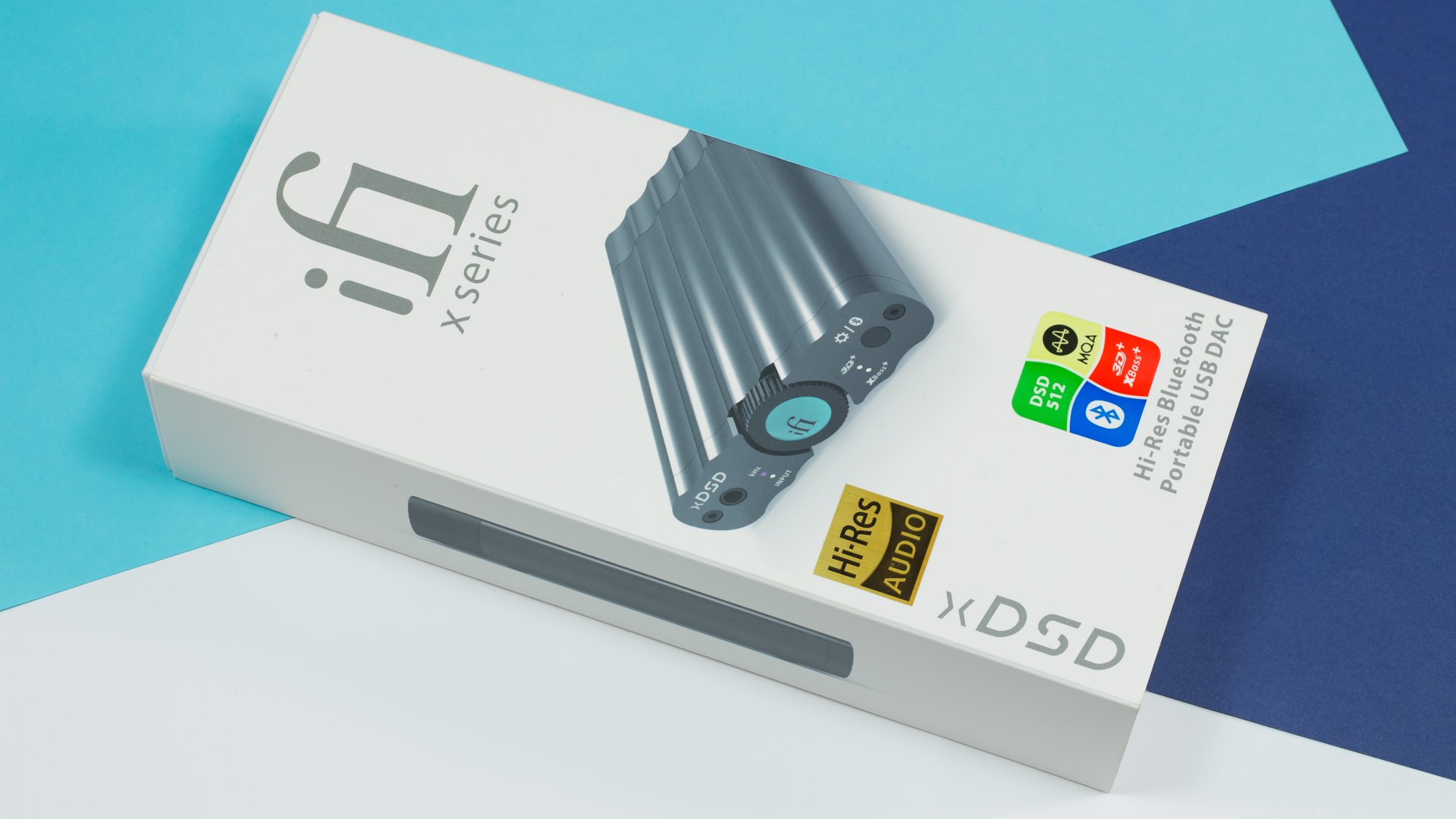
What’s in the box?
- iFi-Audio xDSD
- USB data cable
- USB-A to USB-B adapter
- USB-A to USB-B cable
- 3.5mm Optical adapter
- Storage pouch
- Dual lock strips
- Warranty / Instruction guide
Accessories
With the xDSD, iFi included pretty much all of the bits and bobs that we’ve grown accustomed to receiving with their portable devices. The various included adapters ensure that you can use the device on your desktop rig even if you don’t necessarily have the correct USB cable at hand. The only parts missing from iFi’s usual array are the silicon/rubber bands, silicon stacking pad, and their famous purple RCA cables. In the case of the xDSD, the stacking pad and bands would not only be unnecessary, but actually somewhat useless due to the shape of the device. Instead, iFi included some Dual Lock with which you could attach a DAP (or phone) to the xDSD. This method tends to be “cleaner” and often more practical than using bands to secure a device, especially in the case of a smartphone or DAP that utilises a large touch display.
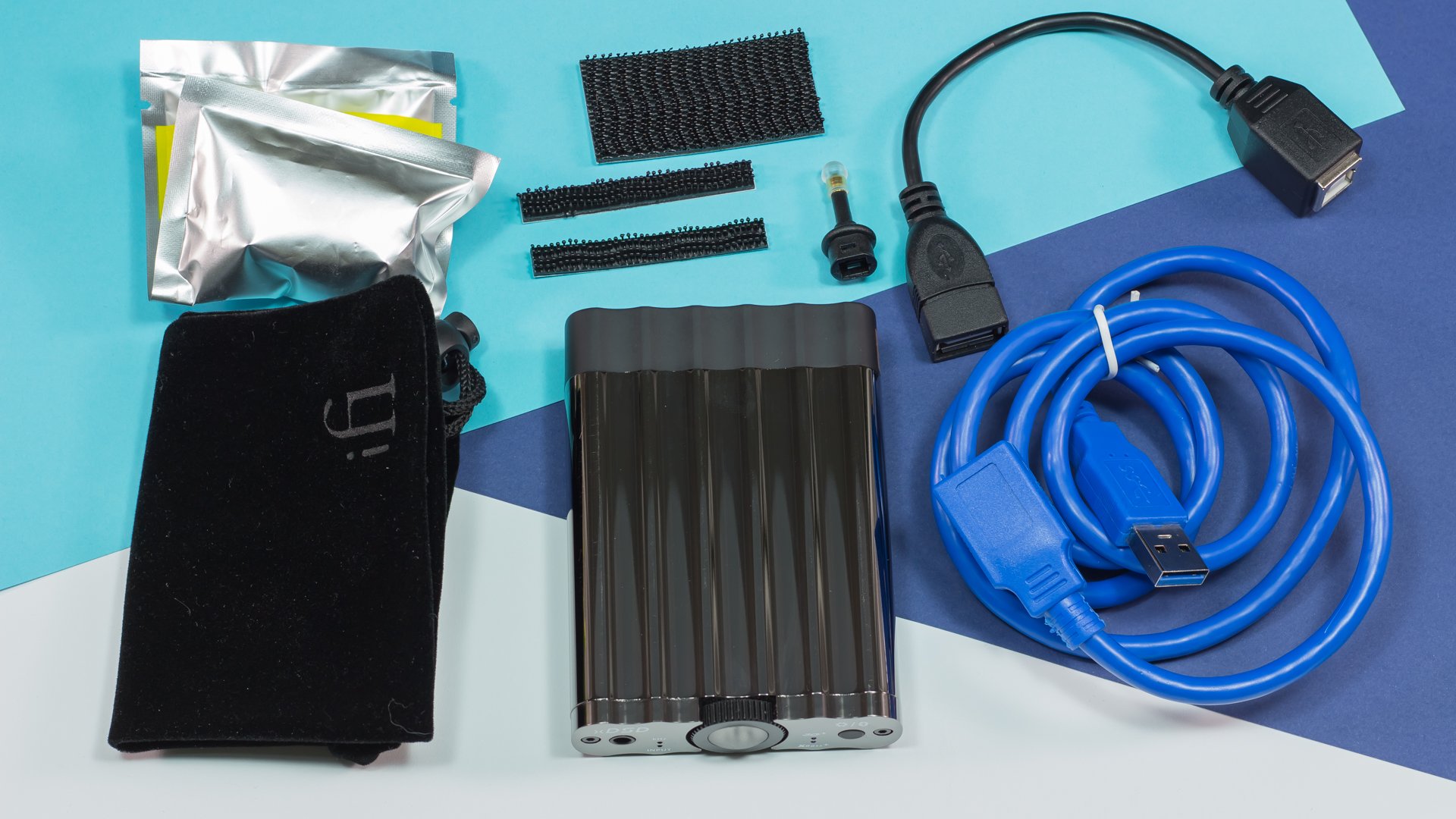
Design
The xDSD is the first and only product in iFi’s “x” model lineup. In fact, the design of the xDSD is unlike anything we’ve seen thus far from iFi. The only slight “hint” of a resemblance to any of iFi’s other products would be that of their Pro line. The slightly corrugated design of the Pro iCan and Pro iDSD’s case is carried over onto the enclosure of the xDSD, albeit far more dramatically. In the case of the xDSD the design resembles corrugated sheet metal much more closely, making for an interesting yet awkward design.
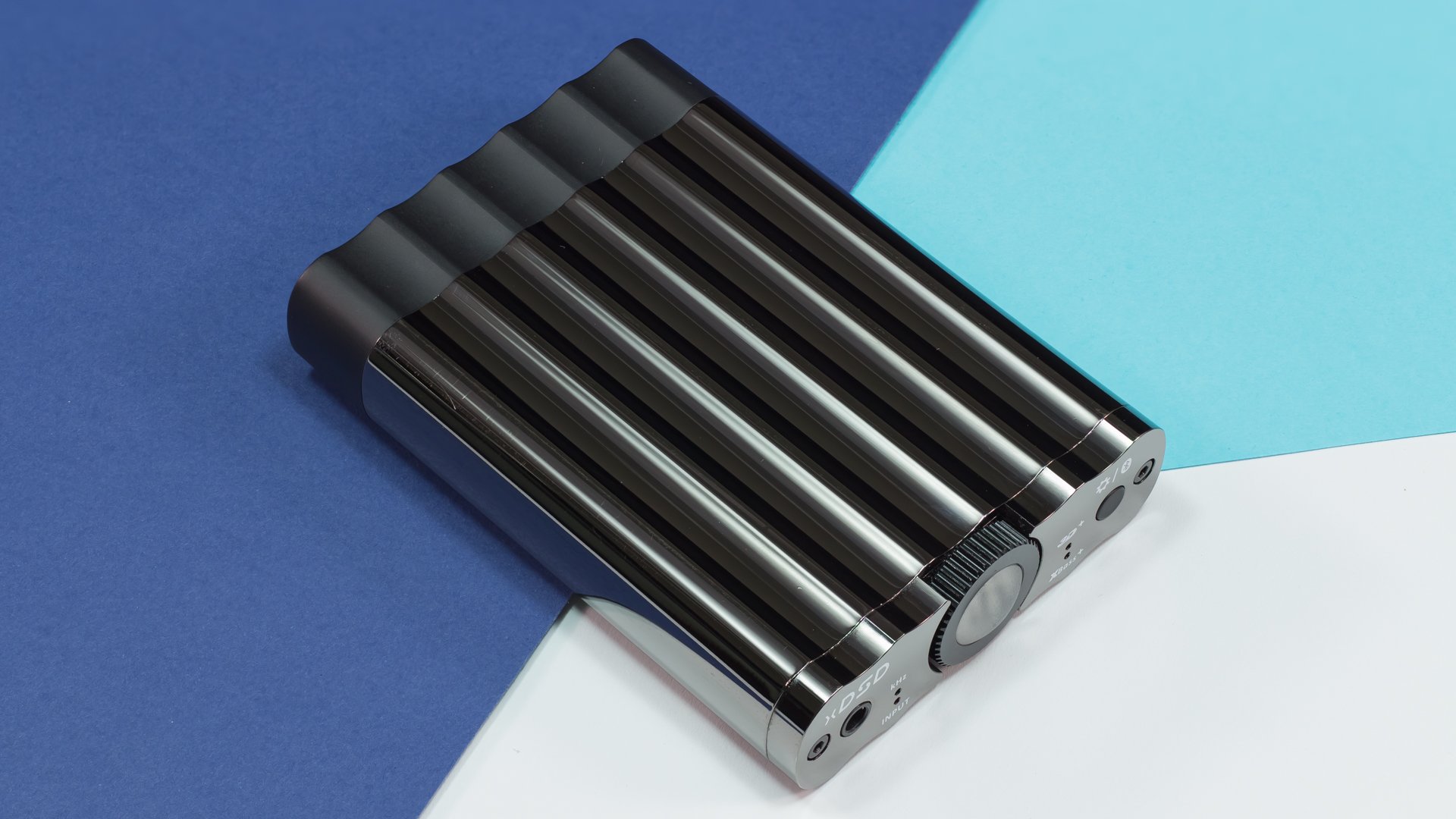
The awkwardness of this design element becomes apparent when we consider the implications it has on “stacking” a DAP or smartphone to it. Due to a lack of a flat surface, it’s not really possible to use the regular ol’ ‘silicone pad and rubber-band technique’. Instead, the provided Dual Lock strips are needed here. This would require you to stick the thinner strips in between the crests of the corrugated casing, and the larger piece is to be stuck to the rear of the source device.
Moving on to the rest of the design, the xDSD’s case has 2 different finishes due to the fact that there are 2 different materials used. Both the main chassis as well as the front plate is made of metal, but the rear portion is made out of plastic. This was required as the Bluetooth transmission would struggle to pass through a metal rear-plate.
The metal parts are coated in what appears to be a sort of gun-metal grey, and an extremely glossy (almost mirror-polish) finish. This does make the xDSD exceptionally susceptible to fingerprints, and could potentially also make scratches to the finish rather obvious. Had iFi kept the same colour but given the device a matte-metallic finish instead, it would have been far more resistant to showing fingerprints and the effects of wear-and-tear.
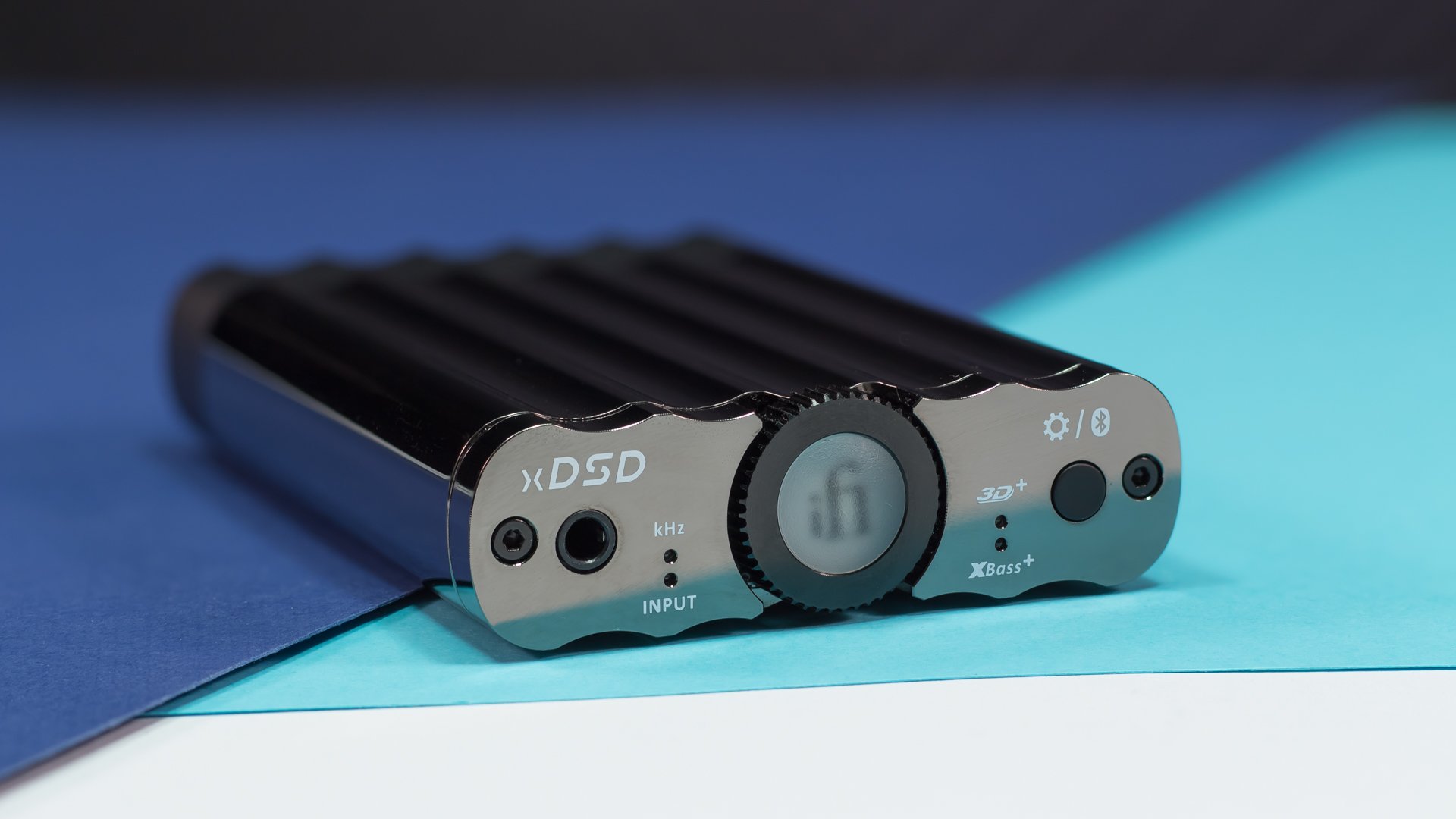
On the front of the device (the faceplate) we get a headphone jack which can be used with both single ended and balanced connection (3.5mm in both scenarios), just like we saw on the Nano iDSD Black Label. Here the xDSD has lost out on the IEMatch function that can be found on both the Micro and Nano iDSD Black Label, which means that some hiss can definitely be heard on ultra-sensitive IEMs like the Dunu DK-3001 (13Ω, 110dB/mW) when music isn’t playing. But, this hiss isn’t noticeable at normal listening levels.
Next there are 2 LED indicators which are independently used to denote the current sample-rate being fed to the device, as well as which input has been selected.
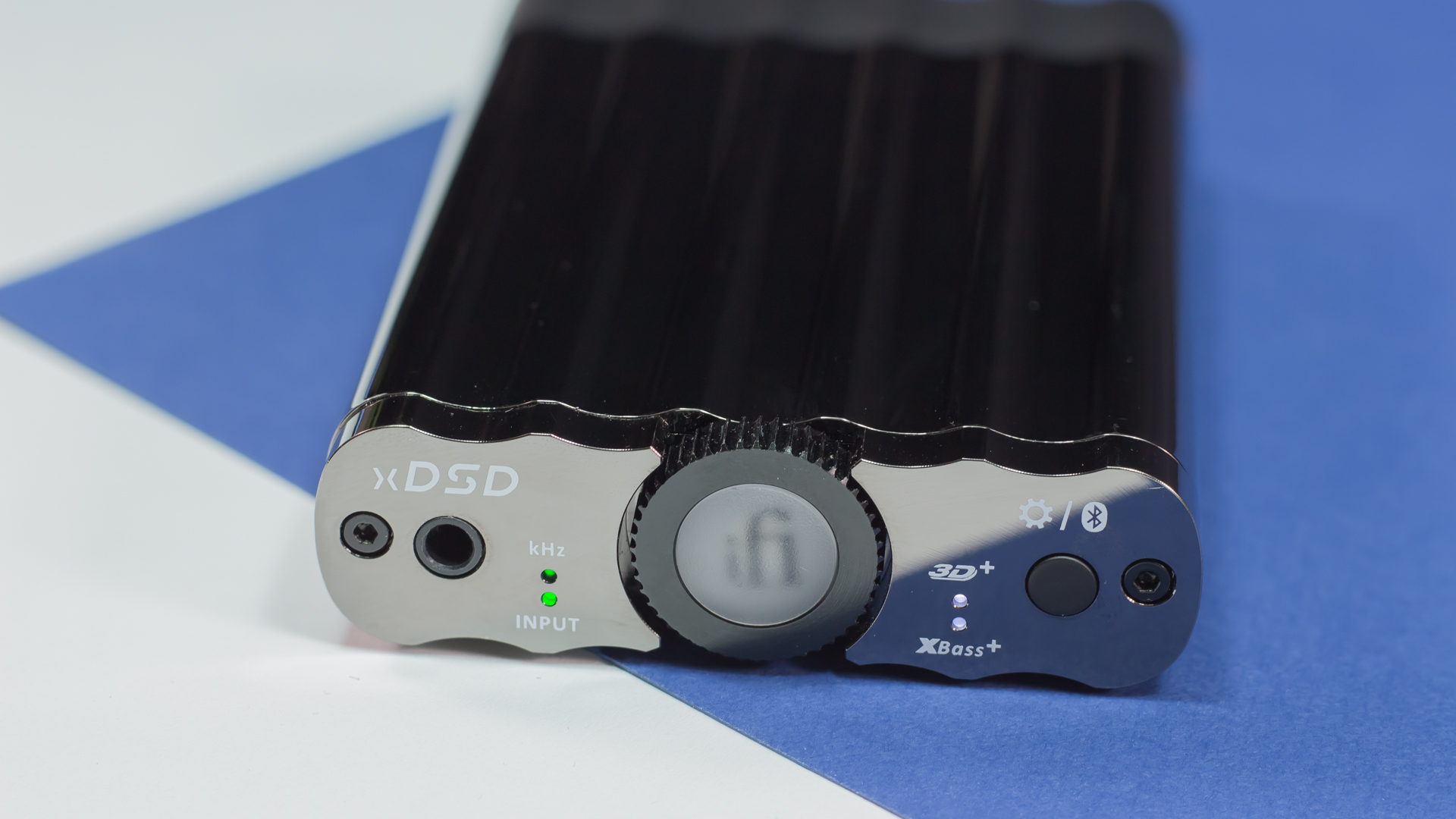
The centre of the faceplate houses the large volume-control knob, which also acts as a power-switch. However, instead of turning the knob to power the device on/off, it needs to be pressed in and held for about 2 seconds. The knob also houses an LED which is used to indicate what the current volume level is. This is very similar to how Chord indicates various functions and levels on the Mojo and Hugo 2.
The control knob also has distinct clicks when turning, and also has no start or end points. This suggests that the actual volume control might be digital, but iFi explicitly states that the xDSD’s actual volume control operates entirely in the analogue domain.
I did notice here a little quality control issue, though, as the knob isn’t centred quite correctly. However, this won’t have any negative influence on the actual functionality of the part.
Moving towards the right of the faceplate are 2 more LED indicators to show the status of the 3D+ and XBass+ effects, and lastly we get a “Setting” button which is used to cycle through the aforementioned effect, and/or to put the xDSD’s Bluetooth module into pairing mode.
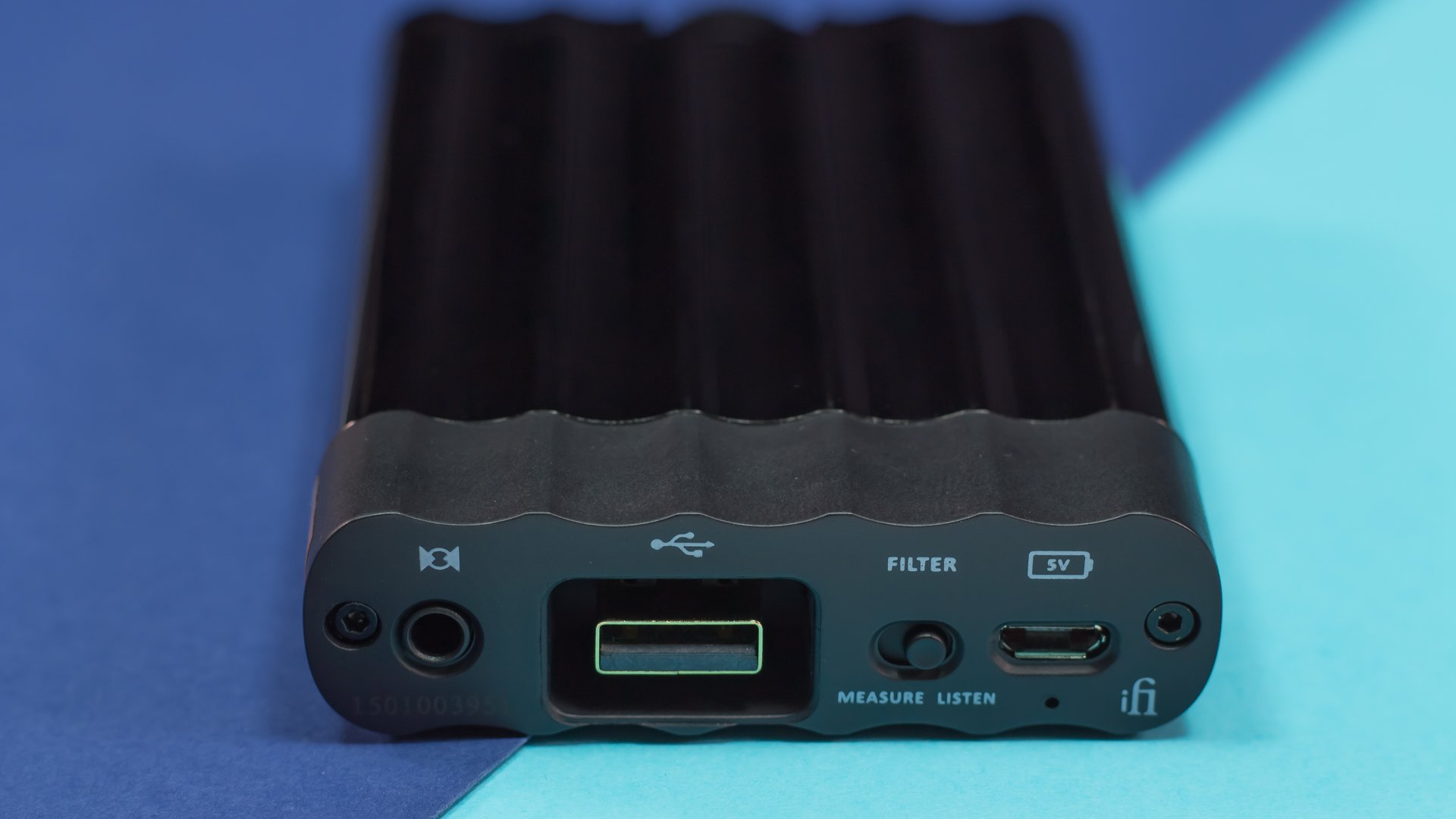
Finally we move to the rear of the xDSD which houses the COAX/Optical combo port, a male USB-A connector (as we’ve seen on various Micro and Nano devices from iFi), a filter switch to select between the measure and listen digital filters, and a microUSB connector. Unlike iFi’s previous portable devices, the xDSDs male USB-A connector functions solely as a data input port, and so cannot be used to charge the internal battery. Thus the microUSB port is used to connect the xDSD to an external source of power.
The xDSD has a slightly larger footprint than the Nano iDSD BL (less than 5% larger), but is also a considerably thinner device, making it noticeably more compact than the Nano iDSD BL overall, and it also feels less “hollow”, more premium than the Nano iDSD BL.
Functionality
Due to a lack of buttons and the amount of features built into the xDSD, accessing all of those features can be a little unintuitive to some extent. For example, as mentioned previously, to turn the device on the power knob needs to be held in for around 2 seconds. But, this is also the same steps required to switch between Bluetooth and wired mode. So, let’s say that the last mode you used was USB input – pressing in and holding the power button for 2 seconds and releasing the button will power the device on and it’ll be back in wired mode, and the same is true for Bluetooth mode.
However, in order to change modes, this requires you to press and hold the power button when the device is off for 4 seconds (2 more than when simply turning the device on). What this means is that, if you want to change modes, you must first turn the device off. That’s not exactly the end of the world, but just a little inconvenient.
Then there’s something else that a little annoying, and actually a bit weird. For whatever reason, if the xDSD has been powered off for more than about 30 seconds, when turning the device on again the XBass+ function will be turned on. But, if you turn off that function, then switch off the device and then turn it back on again before 30 seconds have elapsed, then the XBass+ function will still be in whatever state you left it before turning the device off (either on or off).
The last little issue here is that, because you’re required to use the same button to cycle between the XBass+ and 3D+ effects, it’s impossible to really be able to compare the effects. For example, let’s say that both effects are turned off – pressing the setting button once will turn on XBass+. Pressing the button again will turn off XBass+, but at the same time turn on the 3D+ effect. Pressing the button again will leave 3D+ on and turn on XBass+ as well. So, if you just wanted to cycle between the 3D+ effect, you can’t do that, and likewise for just the XBass+ effect.
There’s also a lineout mode, meaning you can take the signal directly from the DAC chip and completely bypass the amplifier circuit. To do this, we once again have to turn off the device completely. Then, whilst pressing and holding the setting button, press and hold the power button as usual, but let go of the power button and continue to hold the setting button for a further 3 seconds once the power button lights up for the first time. If the xDSD is in lineout mode, the power button will be lit in a solid white colour. To turn off lineout mode, simply repeat the process. there is no preamp level control for the lineout signal though.
So, changing modes and so forth certainly isn’t exactly rocket science, but it can be a little cumbersome.
Sound
If there’s one capability that iFi lacks entirely, beyond the shadow of a doubt, it would to create poor sounding equipment. It doesn’t matter which of their products we look at,
iFi always delivers very well in this regard.
The xDSD is no different as it lives up to the expectation of excellent sound reproduction in quintessential iFi fashion. Music comes across as being organic and engaging, drawing you in and surrounding you with a sense of enjoyment and relaxation. But it’s when you actually sit down and compare the sound of the xDSD to it’s other siblings that you realise just how much bang-for-buck is packed into the xDSD.
xDSD vs. Nano iDSD Black Label
This is perhaps the most obvious comparison to make, as both devices are intended to be used for the same purpose – near-desktop performance in an ultra-portable package.
Discerning sonic differences between the 2 devices isn’t quite as obvious as one might think, as it requires a good couple of minutes for your ears to acclimate to one of the devices, after which switching to a different device reveals those differences more prominently. In terms of sonic character, the Nano iDSD BL sounds somewhat “thinner” than the xDSD. It’s as though there’s just a little bit of added warmth and fullness to the xDSD’s sound. Perhaps due to this apparent “thinness”, the Nano iDSD BL comes across as having a brighter signature in comparison. And yet, despite the brighter character of the Nano iDSD BL, the xDSD also renders musical notes with greater definition and less “smoothness”. When it comes to how smooth a device portrays the audio signal, that “smoothness” can come across as either being refined (i.e not analytical, yet notes are still well defined), or it could make it seem like the music is a bit “smeared” together. The Nano iDSD BL definitely falls more in the latter category when compared to the xDSD.
Read:IFI Nano iDSD Black Label DAC/AMP Review
xDSD vs Micro iDSD Black Label
This may seem like a more unfair battle, as the Micro iDSD BL is certainly intended to be more of a Jack of all trades powerhouse than the xDSD, but again, their sound has more in common than what you might expect.
Hearing the differences between these device again showed how well the xDSD performs and it impressed me a lot, especially considering its size compared to the barely portable Micro iDSD BL.
The most obvious difference in their character was that the xDSD seemed more “congested”. There also seemed to be less “air” between the instruments, which makes the Micro iDSD BL sound “bigger” and portrays a slightly wider sound stage.
There’s also a more refind sound coming from the Micro iDSD BL, as it offers a smoother character, but without making the sound feel smeared either.
The Micro iDSD BL’s sound incorporates all of the favourable characteristics of the Nano iDSD BL and that of the xDSD. That extra refinement shows, but the xDSD really is right on its heels.
Read:IFI Micro iDSD Black Label DAC/AMP Review
Value
Value is something I’ve personally come to appreciate from iFi. What I appreciate most, however, is that they seem to be following the exact same pricing scheme to what I would’ve done, in the sense that it mimics my philosophy on how a manufacturer of audio products should price their products in relation with one another.
At an MSRP of $400, the xDSD sits squarely in the middle between the Nano iDSD BL and the Micro iDSD BL. And yet, their actual sound quality isn’t exactly a far cry from one another. iFi doesn’t go and intentionally cripple the sonic performance of their devices in order to “make them fit” into a designated slot within their product portfolio, but instead they do the best that they can for that price category and add in features accordingly.
The xDSD might cost double that of the Nano iDSD BL, but with that jump in price does come an improvement in sound quality, extra features, and a more compact size. The extra cost is justified.
In comparison to the Micro iDSD BL, the xDSD doesn’t have nearly as much power available, but it does add Bluetooth capability and a far more compact design. Sure, it does lose out on some of the Micro iDSD BL’s other features, but most of what the Micro iDSD BL’s got is available on the xDSD too.
Overall, when looking at all 3 of these devices, the xDSD actually seems like the device that packs the greatest bang-for-buck. Unless you actually need the extra power of the Micro iDSD BL, or a device that can pretty seamlessly morph between a portable solution and a desktop one, then the xDSD makes much more sense in terms of a truly compact and portable Hi-Fi DAC solution. Whatever your personal need is, one thing’s for damn sure…iFi really knocked this one out of the park!

